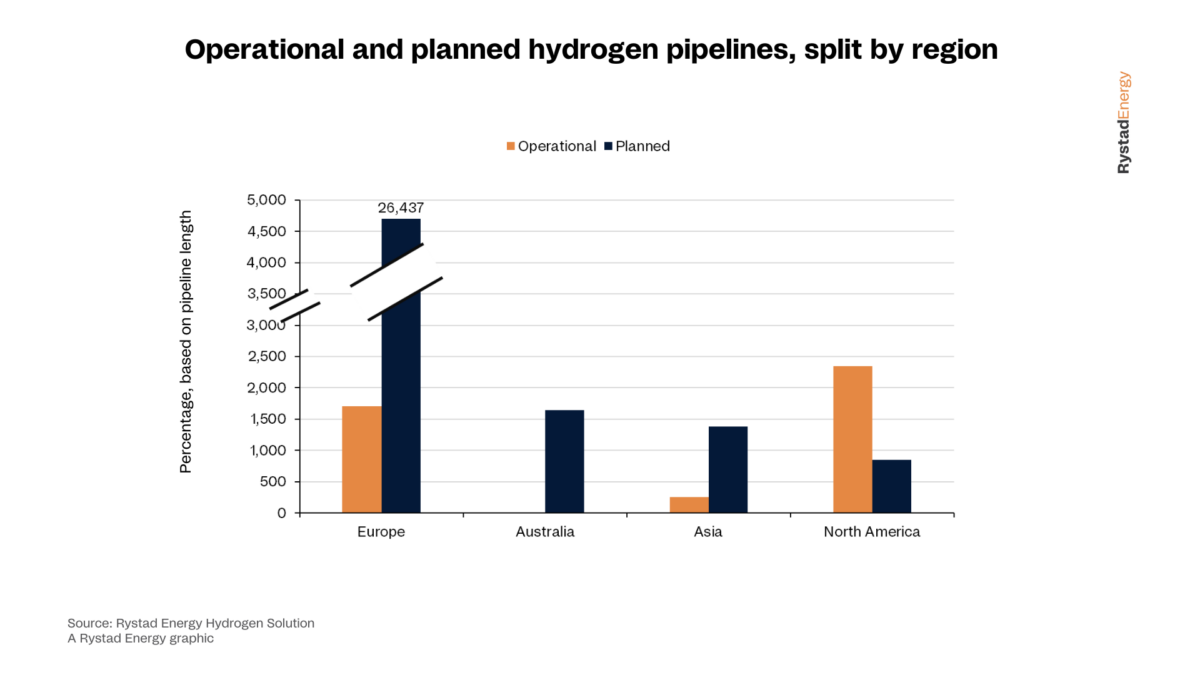Rystad Energy said hydrogen pipeline projects could expand by as much as 700% over the next 12 years. It said that more than 4,300 km of pipelines already transport hydrogen, with more than 90% of them in Europe and North America. It estimates that there are about 91 planned pipeline projects throughout the world, with 30,300 kilometers set to go online by around 2035. “Spain, France, and Germany are among the countries committed or considering cross-border pipelines to facilitate energy flows, while the UK with its extensive gas grid finds itself in a fantastic position to switch from natural gas to hydrogen,” it noted.
Dominion Energy Utah (DEU) has launched hydrogen blending in Delta, Utah, as part of an ongoing project. It said it tested a 5% hydrogen blend for almost a year and found “that hydrogen was safe, compatible with current residential appliances and helpful in reducing emissions from appliances using already clean-burning natural gas.” The second phase consists of a blend of up to 5%. It will be introduced to the city and several surrounding towns, serving about 1,800 customers in total.
Ingeteam has developed a new rectifier to power electrolyzers based on insulated-gate bipolar transistor (IGBT) technology. The new product is designed for large-scale green hydrogen production plants. The company said it will supply the first units in September for projects in Germany and Spain.
H-TEC Systems has developed a modular hydrogen electrolyzer for large-scale projects above 10 MW in size. The German company said it can combine 10 MW blocks of the modular hydrogen platform into systems with an electrolysis performance of 100 MW and above. The overall system efficiency of 77%, along with high system availability, results in low hydrogen costs, it claimed. The blocks are based on S450 stack technology and the systems are designed for indoor installation.
Popular content
Toyota and the Japan Fine Ceramic Center have developed a new observation technique in which test samples are placed in an exact simulation of a fuel cell stack, in order to observe the coarsening process at all stages during electricity generation. “The focus of its research is the way in which platinum in the fuel cell stack catalyst ‘coarsens' over time,” said Toyota. “These changes at particle level have an impact on the metal’s performance supporting the chemical reaction between hydrogen fuel and airborne oxygen to create the electricity that powers the vehicle engine.” Coarsening is the process through which particles of different sizes transform into fewer particles with larger average sizes.
Nigerian researchers have shown that energy systems combining diesel generators, solar, wind, hydrogen, and batteries could reach “renewable fractions” of between 98% and 100% in the city of Abuja and the town of Anyigba. “Like the battery bank, the operational analysis of the hydrogen system shows that it can mitigate intermittency of solar PV panels and wind resources,” the team said in “An energy balance and multicriterial approach for the sizing of a hybrid renewable energy system with hydrogen storage,” which was recently published in e-Prime – Advances in Electrical Engineering, Electronics and Energy. “This present study elucidates the prospects and benefits of adopting hydrogen energy storage.”
The European Commission has approved a €450 million ($490 million) scheme in Italy to support the production of renewable hydrogen. The public support will take the form of direct grants to cover investment costs, with a maximum amount of €20 million per project.
This content is protected by copyright and may not be reused. If you want to cooperate with us and would like to reuse some of our content, please contact: editors@pv-magazine.com.


Its all very well to consider hydrogen to power gas boilers as suggested here, but that is a very inefficient way of using the electrical power that split the water molecule to make hydrogen. Firstly electrolysis is inefficient, around 65%, then the best condensing gas boiler in condensing mode, and many are not, is only about 95% efficient in extracting heat from the gas combustion, so the whole process, not allowing for pipeline losses, is about 60%. A ground source heat pump will deliver 400% of the energy to run it; and air source will deliver around 280% depending on the average air temperature. Saving energy with better insulation and more efficient equipment is key to decarbonising (fossil carbon) our emissions.
There is a new discoveryabout high efficiency electrolysis – about 98% – https://www.nature.com/articles/s41467-022-28953-x
On the other side it would not be necessary to cut up the wind production in the night, for example.